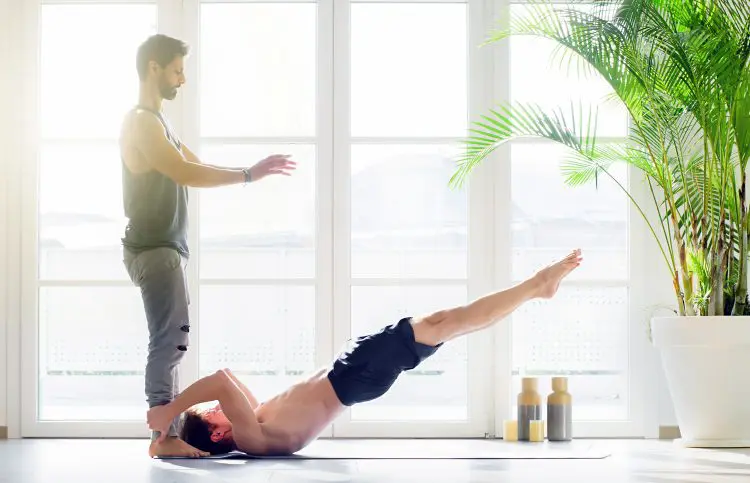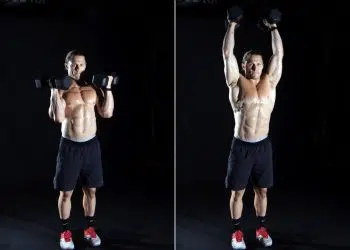Front lever raises look impossible! When properly performed, your body appears to defy gravity. Unlike front lever holds, which are an isometric exercise, front lever raises are a dynamic exercise that starts from a dead hang and involves raising your body while keeping your hips, legs, and arms straight.
One of the most challenging calisthenic exercises you can do, front lever raises may beyond your reach if you have long or muscular legs or are otherwise overweight. Leverage and body weight are important and unavoidable factors. It’s no coincidence that most gymnasts are short, lean, and have slender (but still strong and powerful) legs.
To get an idea of how you do front lever raises, imagine doing straight arm pullovers. But, instead of holding your body in place and lifting a weight, your arms stay stationary, and you lift your body instead.
Needless to say, this move requires a lot of strength, and not everyone is built to do front lever raises successfully.
In this exercise, we explain how to do this exercise and provide you with some variations in case you aren’t quite strong enough to do them.
Front Levers – Muscles Worked
Front levers are a compound exercise, which means they involve multiple joints and muscles working together. The main muscles involved in front levers are:
Level Up Your Fitness: Join our 💪 strong community in Fitness Volt Newsletter. Get daily inspiration, expert-backed workouts, nutrition tips, the latest in strength sports, and the support you need to reach your goals. Subscribe for free!
Latissimus dorsi
Known as the lats for short, these large back muscles are responsible for shoulder adduction and extension. Strong lats are a must for front lever raises. During this exercise, your lats extend your shoulders, pushing your arms downward to raise your body up.
Triceps
Located on the back of your upper arm, the triceps extend your elbows and your shoulders. Your triceps work with your lats to push your arms downward and lift your body.
Core
The collective term for the muscles of your midsection, including the rectus abdominis, obliques, transverse abdominis, and erector spinae. Along with your hip flexors (iliacus, psoas), your core holds your midsection straight.
Quadriceps
Front lever raises are performed with perfectly straight legs. This is the job of the quadriceps, which is the collective name for rectus femoris, vastus lateralis, vastus intermedius, and vastus medialis.
While these are the main muscles involved in front levers, the reality is that this exercise involves your entire body, from your hands to your feet, via everything in between! Subsequently, it’s best to think of front levers as a full-body exercise. If you have any weak muscles, front levers will undoubtedly expose them.
How to Perform Front Lever Raises
Front lever raises are a gymnastic movement, so doing them is as much about skill as it is strength. Learning to do front lever raises will take time and practice. Don’t worry if your first few workouts are unsuccessful; persevere and, with dedication and a little bit of luck, you may eventually graduate to doing front lever raises.
- Hang from a pull-up bar with an overhand, shoulder-width grip. Your arms and legs should be straight. Brace your core, and pull your shoulders down and back.
- Lean back, and simultaneously push your arms forward to raise your legs. Keep your body straight.
- Lift your legs to parallel to the floor or if you prefer, until you are fully inverted. The inverted version is slightly easier as you get a brief rest between reps.
- Lower your legs smoothly and under control and repeat.
- Each rep should start from a dead hang; swinging (kipping) is not allowed! Your arms, legs, and hips should remain straight during front lever raises.
Front Lever Raises Benefits
Front lever raises are a very demanding exercise, so you may be wondering if they’re worth the time and energy it will take to master them. Here are some of the benefits of this hardcore calisthenic exercise:
No equipment required – all you need to do front lever raises is a pull-up bar. That means you can do them almost anywhere; at home, in the gym, or at a playground. You could also do them from a tree branch, but you should check it’s strong enough first because your injuries could be severe if it breaks.
An advanced lat exercise – if you’ve progressed beyond pull-ups and are looking for a more challenging lat exercise, front lever raises could be just what you’ve been looking for. The movement is different, but front lever raises are a great way to build bigger, stronger lats.
Build a stronger core – holding your body straight during front lever raises requires and will develop impressive core strength. If you want to take your core training to the next level, maybe to progress to full front lever holds or human flags, this exercise will help.
A major calisthenic milestone – like handstand push-ups, double bodyweight deadlifts, and running a mile in five minutes, front lever raises are a significant fitness milestone. Working toward doing this exercise will increase muscle size and strength and should bring a real sense of achievement.
Front Lever Raises Alternatives and Variations
Front lever raises are a TOUGH exercise, and most people will need to work up to doing them. Even then, there are no guarantees of success. Here are some variations and alternatives that target the same muscles and that you can use to prepare your body for doing “real” front lever raises.
1. Hollow rocks
To do front lever raises, you need the core strength to hold your body straight. Gymnasts use an exercise called hollow rocks to develop the core strength necessary to do front lever holds and front lever raises.
If you’ve mastered planks and are looking for a more demanding core exercise, this move is highly recommended.
How to do it:
- Lie on your back with your arms above your head, biceps next to your ears. Brace your abs and raise your arms, head, shoulders, and legs off the floor, so your body forms a shallow C-shape. There should be no space under your lower back. Press your legs together and point your toes.
- Maintaining this position, and without flexing your hips or shoulders, roll your weight toward your feet and then up to your upper back.
- Continue rocking until you are unable to maintain the hollow position.
2. Front lever raises – negatives
You are stronger eccentrically than you are concentrically. That means you can lower more weight than you can lift. Use this phenomenon to build the strength necessary to do front lever raises.
Level Up Your Fitness: Join our 💪 strong community in Fitness Volt Newsletter. Get daily inspiration, expert-backed workouts, nutrition tips, the latest in strength sports, and the support you need to reach your goals. Subscribe for free!
How to do it:
- Hang from a pull-up bar with an overhand, shoulder-width grip. Your arms and legs should be straight. Brace your core and pull your shoulders down and back.
- Swing your legs up so that you are hanging upside down. Your body should be straight and vertical.
- Without bending your arms, hips or knees, engage your lats and lower your body down and into the dead hang position.
- Drop to the floor and rest, or raise your legs up and do another rep.
- You can also do this exercise with your legs bent, which will shorten the lever and make it easier.
3. Tucked front lever raises
Leverage matters with front lever raises. People with long legs usually find this exercise harder than people with short legs. While you can’t do much about the length of your legs, you can bend them to create shorter levers and make front lever raises somewhat easier.
How to do it:
- Hang from a pull-up bar with an overhand, shoulder-width grip. Pull your shoulders down and back. Bend your legs and pull your knees up toward your chest – the tuck position.
- Lean back, and simultaneously push your arms forward to raise your legs. Keep your body straight.
- Lift your body until it’s parallel to the floor or if you prefer, until you are fully inverted. The inverted version is slightly easier as you get a brief rest between reps.
- Lower your legs smoothly and under control and repeat.
- Each rep should start from a dead hang – swinging (kipping) is not allowed!
4. Dragon flags

The dragon flag is a killer core exercise that may or may not have been invented by martial arts legend Bruce Lee. From a core perspective, it’s very similar to front lever raises. However, dragon flags are not such a lat-centric exercise. If you want to work on your core more than your lats, this could be the exercise for you. Take care, though; this is an intense exercise that’s only suitable for people who already have a strong core.
How to do it:
- Lie on your back on an exercise bench. Grip the bench on either side of your head to keep your upper body stable.
- Raise your legs so that they’re vertical and your weight is on your upper back and head only. Brace your abs and lock your legs straight.
- Keeping your body and legs as straight as possible, lower yourself down until your feet are just a few inches from the floor. Your legs, butt, and back should NOT touch down.
- Pull yourself back up to the vertical and repeat.
- This exercise can also be done with your legs bent – a tuck dragon flag – which is considerably easier.
5. Hanging toes to bar
If your lats are strong but you lack the core strength to do front lever raises, this exercise may help. Unlike front raises, you are allowed to bend your hips for this exercise, but your legs should remain perfectly straight.
How to do it:
- Hang from a pull-up bar with an overhand, shoulder-width grip. Your arms and legs should be straight. Brace your core and pull your shoulders down and back.
- Bend your hips and lift your legs up until your toes touch the bar between your hands.
- Slowly and smoothly lower your legs and repeat.
- Do not use momentum to raise your legs. Lift them slowly and with control to keep the tension on your core muscles.
6. Barbell rollouts
Like front lever raises, barbell rollouts work your core and lats. Also, like front lever raises, your arms should stay straight during this exercise. Do rollouts on your knees for a medium-intensity core and lat workout, or from standing to kick the intensity up higher. You can also add weight to your bar to make them even harder.
Read more about rollouts in this detailed exercise guide.
7. Straight arm pulldowns
While this exercise is nowhere near as hard as front lever raises, it will teach you to feel the right muscles (lats and abs) working. It’s also an excellent warm-up exercise before moving onto front lever raises.
How to do it:
- Attach a straight bar to a high pulley machine. The bar should be above head height. Hold the bar with an overhand, shoulder-width grip. Straighten your arms.
- Stand with your feet about hip-width apart, core braced.
- Without bending your arms, push the bar down in an arc until it touches your thighs.
- Raise your arms and repeat.
- You can also do this exercise with a resistance band.
- Focus on using your lats – picture them working – to increase your mind-muscle connection.
Front Lever Raise Tips
Get even more from this exercise with these handy tips!
Grease the groove
Front lever raises are a much about skill as they are strength. Get better sooner by using the grease the groove (GTG) technique. GTG basically means doing lots of reps daily to speed up the learning process. If you are serious about mastering front lever raises, try doing a lot of sets of just 1-3 reps throughout your day.
Read more about greasing the groove in this detailed guide.
Chalk those hands
Whether you raise your body to parallel or until you are fully inverted, dry hands are a must. The last thing you want is for your grip to fail, so you fall and hurt yourself. This is a challenging exercise, and it’s only normal for your hands to sweat. Avoid slips and falls by chalking your hands before each set.
Video yourself
Your hips, knees, and arms should be perfectly straight during front lever raises. However, just because you think your body is straight doesn’t mean it is. Get valuable feedback by periodically videoing your front lever workouts. That way, you’ll be able to see whether or not you are doing them correctly.
Adjust your sights if necessary
If you’ve got big, long legs, you may never be able to do full front lever raises. Don’t get disheartened! Negative and tucked front lever raises are both great exercises, even though they’re a little easier. In fact, any of the exercises on our list of variations and alternatives will provide you with a good workout. Not everyone is built to do front lever raises. For some people, the potential risks outweigh the benefits.
Front Lever Raises – Wrapping Up
Front lever raises are an impressive, demanding lat and core exercise. In fact, they work pretty much every muscle in your body. With more in common with gymnastics than the weight room, this exercise demands and will develop impressive levels of strength and also involve a lot of skill. Because of this, not all exercisers will be able to do them.
The good news is that there are several easier variations of this exercise and plenty of alternatives that you can do to work the same muscles.
You’ll never know if you can do front lever raises until you try, so put the information in this guide to good use and find out!
Interested in measuring your progress? Check out our strength standards for Push Ups, Pull Ups, Deadlift, and more.











